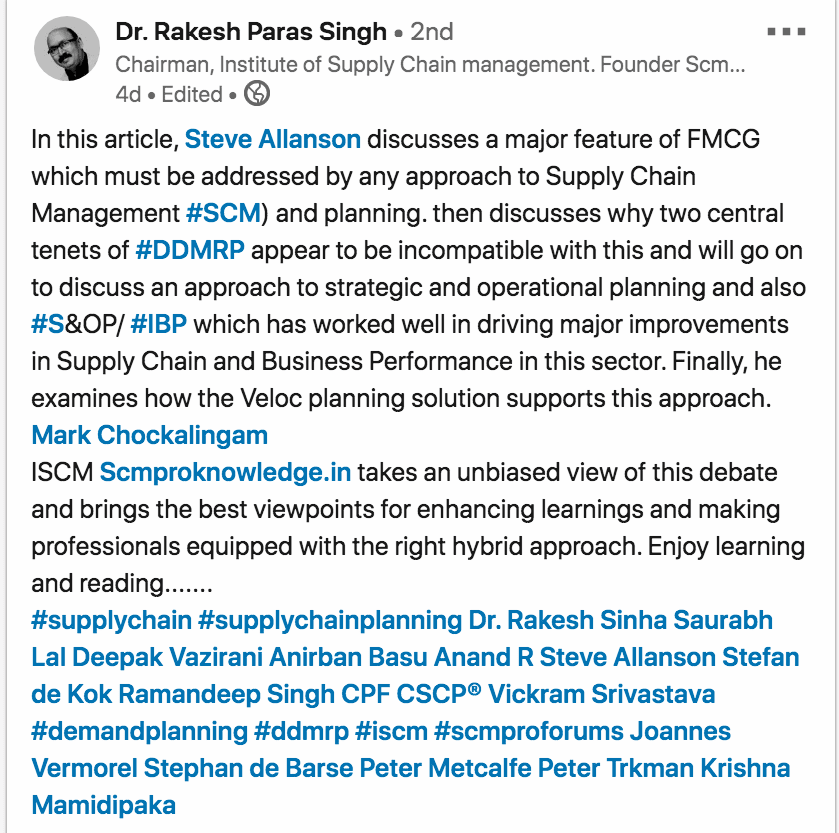How the Demand Driven Institute Tries to Make DDMRP Unfalsifiable
Executive Summary
- The Demand Driven Institute has some rules they would like you to follow when critiquing DDMRP.
- If you follow them, DDMRP cannot be critiqued.

Introduction
The Demand Driven Institute, led by Chad Smith and Carol Ptak, makes significant efforts to stop those with extensive experience in the MRP, forecasting, and supply planning space from critiquing their creation of DDMRP. By observing multiple interactions and debates, mostly on LinkedIn, the Demand Driven Institute’s strategy has become apparent.
Our References for This Article
If you want to see our references for this article and related Brightwork articles, see this link.
This article will lay out a technique that I have called “eliminated the testability of DDMRP.”
The Rules Set Out by DDI for Testability
The following was explained by Chad Smith of the DDI on the rules for critiquing DDMRP. This is the share on LinkedIn.

This is the article Can DDMRP Work in the FMCG Sector?
This is in response to the following share by Rakesh Paras Singh.
Dr. Rakesh Paras Singh – Please, do not just make this a DDMRP discussion. This is where so many of us are missing each other. DDMRP is simply a supply order generation and management engine. We constantly try to tell people is only a part of a bigger picture – a part that is a starting point (albeit it a rewarding one) to a larger transformation. – Chad Smith
This is the response to Chad.
ISCM Scmproknowledge takes an unbiased view of this debate and brings the best viewpoints for enhancing learnings and making professionals equipped with the right assessment of the approach. Enjoy learning and reading…. i have said this. You are right Chad Smithwe will broaden the debate and would request a thought leadership approach to prevail here.
I have demand planning approaches in mind and not just DDMRP. The bigger picture is where focus in the supply chain or even businesses is absent. I would love the debate to move beyond the question of replenishment metrics and strategy of designing and managing supply chain better. Most probably how will planning be planned post pandemic in near short, Short and long period? bringing this gap in demand planning is important? And there are many ways to do it. – Rakesh
This is the response to Rakesh.
If you want the debate to be about that broader topic then perhaps you should start with an article about that broader subject. The article you posted was about a particular supply order generation mechanism (DDMRP) in a particular industry (FMCG). That is pretty far off of the broader topic that you hope to foster your discussion around. Why start there? Quite perplexing to me.
We actually have a webinar that we just recorded that talks about two simple conclusions moving forward for companies and their leadership. It is available for free on our website including the deck (Where do Supply Chains go From Here?). https://www.demanddriveninstitute.com/videos We are also about to publish a joint POV with Accenture that will echo these thoughts. – Chad Smith
And then Rakesh’s response.
I am surprised at your objection to the article. I found it broad and the article brings about certain critical element of planning. Why should everybody be a proponent of DDMRP.
The DDMRP proponents needs to be accommodative
Scmproknowledge is a knowledge portal and we will keep publishing and posting all views. I have published another article on DDMRP by dr rakesh sinha. Let’s discuss than say what we can’t do as a portal.Best regards and you are welcome to contribute and I will post it here. – Rakesh
And then Chad’s response.
I am not objecting to the article at all. Please carefully read my post. At no point in any of my posts do I object to you posting this article. It did foster discussion (albeit a discussion that has occurred, at least for me, in many other forums, at many other times over the last few years). What seemed odd to me is that you say you want a broader discussion but posted a specific article about a specific replenishment method in a specific industry. Why not start with the broader question/article if that is the discussion you want to foster as per you post that I replied to? – Chad Smith
And this is where I entered the conversation.
This comment by Chad…
“Please, do not just make this a DDMRP discussion. This is where so many of us are missing each other. DDMRP is simply a supply order generation and management engine. We constantly try to tell people is only a part of a bigger picture – a part that is a starting point (albeit it a rewarding one) to a larger transformation.”
Is worthy of some type of propaganda award.
If any person wishes to write an article about DDMRP, they have the right to do it without being policed to writing about a different or “broader topic.”
The second part of this quote is pure misdirection, also known as a pivot — it proposes that the specifics of an item (like DDMRP) should not be critiqued, because of some more significant issue proposed by an organization (DDI) that does not want that item critiqued.
I could do the same thing. If someone were to critique an article at Brightwork Research & Analysis, I could state, “please do not critique the website, its just a “starting point — albeit it a rewarding one — to a larger transformation.”
If the item itself cannot be critiqued because it is part of a larger transformation that is not actually part of the item, then the item itself has been converted into something that is permanently unfalsifiable or is called an untestable hypothesis. That is, the hypothesis cannot or should not be tested because it is just a cog in a larger machine. But if a hypothesis cannot be tested or analyzed outside of a group that has an incentive to promote it (DDMRP/DDI in this case) — then it is given a protected space — that no hypothesis should have, and that no other hypothesis has in supply planning. I know something about this having engaged in numerous debates with Chad Smith and other DDMRPers. There are only two outcomes of this discussion. You either agree with DDMRP, or you will be accused of not understanding DDMRP. Chad has policed me, Stefan Do Kok, Joannes Vermorel, and now you those are just the ones I can immediately recollect. You are in the early phase of the discussion Rakesh. If you do not submit, you can expect a personal attack. DDMRPers will read this and then make cutting comments. Chad Smith will then jump in double team you — while pretending to be above the fray. – – Shaun Snapp
This is Chad’s response.
I would invite anyone on this forum to review the “debates” that you and I have had in which I have always said people should thoroughly explore and decide for themselves. I would also invite people to review the way you conduct yourself online. We have spent ten years building out a framework that is proving itself over and over again. My point in making the specific post you are responding to was to say that much of the critique of DDMRP has been that lacks this or that. The larger framework is where most of what is claimed to be missing is often found and people miss that and often don’t explore that at all. Have a great day – I think you need one. – Chad Smith
And here is my response.
Let us review the quote because it is challenging to come to that conclusion from your quote.
“Please, do not just make this a DDMRP discussion. This is where so many of us are missing each other. DDMRP is simply a supply order generation and management engine.”
There is nothing here regarding a specific part of DDMRP.
Chad’s comment here…
“DDMRP is part that is a starting point (albeit it a rewarding one) to a larger transformation.”
It can only be interpreted to mean that he thinks DDMRP itself is not analyzed but part of something bigger.
But, as we cover in the article How Accurate is the Criticism of Lokad DDMRP Video? Chad did make the statement he said he made above in a critique of Joannes.
“Joannes also misses the point that DDMRP is a package that is greater than the sum of its parts. By only comparing a part at a time, Joannes fails to understand or address how the components work together to produce a result..”
This attempts to defect the critique of any one part of DDMRP — and that it can only be viewer holistically — not in total.
This means that according to Chad’s/the DDI’s logic, the following rules apply.
The Rules Laid Out by the DDI
- Rule #1: A DDMRP cannot be critiqued because it is part of something greater.
- Rule #2: Specific areas of DDMRP cannot be critiqued because each part can only be analyzed within the construct of a larger part (which is DDMRP).
Let us review this logic graphically.

I will prove that both of these attempts at deflecting criticism cannot be valid.
But I will do so without proposing a normative standard. Instead, I will use Chad’s/DDI’s own critiques.
In their book and articles, Chad Smith and Carol Ptak critique MRP. However, they critique without concern for Rule #1. When critiquing MRP, they never consider that MRP is part of something larger. They critique MRP as its own isolated item (as they should, but not as they say DDMRP should not be critiqued.)
They break Rule #2 by specifically criticizing specific parts of MRP.
- They say that safety stock is not effective.
- They state that forecasts should not be used for operational planning but to set buffer stocks.
This is a critique of a specific part of MRP. In fact, their commentary and the commentary of other DDMRP followers on MRP are littered with specific MRP critiques that could also be defended by stating that MRP must be viewed as a comprehensive whole.

Chad Smith receives our Golden Pinocchio Award for creating a fake set of rules that try to place DDMRP beyond critique.
Conclusion
Neither argument nor rule that sub item to a greater item cannot be critiqued because it is part of a greater “sum of parts” or that the greater item is part of either a larger item or a legitimate defense or rule against criticism. And the DDI breaks these rules when critiquing MRP. These arbitrary rules are put in place to stop DDMRP from being criticized. This is part of a long-term pattern by DDI, as we cover in the article The Demand Driven Institute’s Approach to Suppressing Dissent on DDMRP.
DDI uses a “thug” mentality to critique the person to stop critiquing DDMRP. Chad Smith is the primary enforcer, and he employs a “Mean Girl routine,” but there are many DDMRP devotees who will critique those that do not blindly accept DDMRP.